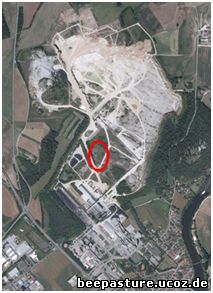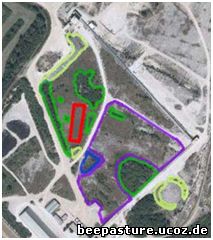 Our project area lies in the centre of the ‘renaturized’ region (see Figures 1 and 2). In direct proximity to the future wild bee pasture, there are some structures relevant for bees, which extend the species spectrum by their ability to form settlements. Of particular significance here are the regions similar to limestone grasslands which already exist as well as the wooden groves close by, a ring of debris to the southeast of the wild bee pasture as well as a debris barrier in the north. The expanse of water also supplies water indirectly to the proximity of the project area, which bees can drink or use to cool their hives. The area for the bee pasture is particularly suitable because the surrounding woods as well as the accumulations of debris form a kind of protective wall, which provides a constant microclimate and minimises disturbances by mining machines driving past.
Our project area lies in the centre of the ‘renaturized’ region (see Figures 1 and 2). In direct proximity to the future wild bee pasture, there are some structures relevant for bees, which extend the species spectrum by their ability to form settlements. Of particular significance here are the regions similar to limestone grasslands which already exist as well as the wooden groves close by, a ring of debris to the southeast of the wild bee pasture as well as a debris barrier in the north. The expanse of water also supplies water indirectly to the proximity of the project area, which bees can drink or use to cool their hives. The area for the bee pasture is particularly suitable because the surrounding woods as well as the accumulations of debris form a kind of protective wall, which provides a constant microclimate and minimises disturbances by mining machines driving past. Fig. 1 Overview of the Quarry, site of the project area red;
Diagram changed according Bayern Viewer, M. Brockard
Fig 2: Immediate environment adjacent to the wild bee pasture,
red: wild bee pasture, purple: limestone grasslands-similar area, green;
wooded groves, yellow: gravel piles, blue: water;
Diagram changed according to BayernViewer, M. Brockard
 Beschreibung der Projektfläche
Beschreibung der Projektfläche
Unsere Projektfläche liegt in der Mitte des renaturierten Bereiches (Siehe Abbildung 1 und 2). In unmittelbarer Nähe zur zukünftigen Wildbienenweide befinden sich einige bienenrelevante Strukturen, die durch ihre Besiedlungsfähigkeit das Artenspektrum erweitern. Von besonderer Bedeutung sind hier die schon bestehenden kalkmagerrasenähnlichen Bereiche sowie nahe Gehölzbestände, ein Schuttring südöstlich der Wildbienenweide sowie eine Schuttbarriere im Norden. Außerdem liefert die Wasserfläche in unmittelbarer Nähe zum Projektgebiet Wasser, welches Bienen trinken oder mit dem sie ihren Bau kühlen können. Besonders geeignet ist die Fläche für die Bienenweide, weil die umgebenden Gehölze sowie die Schuttanhäufungen eine Art Schutzwall bilden, der für ein konstantes Mikroklima sorgt und Störungen durch vorbeifahrende Abbaumaschinen abschwächt.
